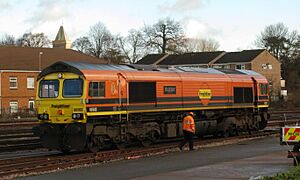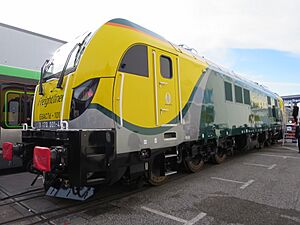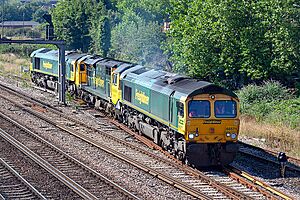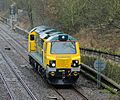Freightliner Group facts for kids
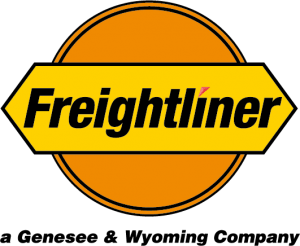 |
|
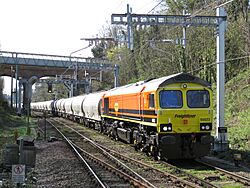 |
|
| Subsidiary | |
| Industry | Rail freight transport |
| Predecessor | British Rail |
| Founded | 1995 |
| Headquarters |
,
England
|
|
Area served
|
United Kingdom Germany Poland Netherlands |
|
Key people
|
Tim Shoveller (CEO) |
| Services | Bulk freight, Intermodal freight transport and logistics |
| Revenue | US$785 million |
|
Number of employees
|
2,500+ |
| Parent | Brookfield GIC |
| Divisions | Intermodal, Heavy Haul, Maintenance |
| Subsidiaries | Rotterdam Rail Feeding Pentalver |
Freightliner Group is a big company in the United Kingdom that moves goods by train. It's owned by two large companies: Brookfield from Canada and GIC from Singapore.
The company started in 1968 as Freightliner Limited. Back then, it was owned by the British government. From the beginning, Freightliner focused on moving goods for international trade. They built special depots near seaports to handle this business.
In the late 1970s, it became part of British Rail, which was the national railway company. Later, in the 1980s, it joined British Rail's Railfreight Distribution section. During this time, they made railway lines bigger. This allowed trains to carry larger containers. Many smaller depots were closed in the 1990s. This happened as British Rail was getting ready to become a private company.
In 1996, Freightliner became a private company. It was bought by its managers for £5.4 million. Freightliner quickly updated its trains. They ordered new Class 57 and Class 66 locomotives. In 1999, they started their Heavy Haul business. Five years later, they launched the Logico service.
By 2014, Freightliner Limited was the biggest company moving containers by rail in the UK. It was also the second-largest freight train company by money earned. Freightliner also started working in other countries. These included Australia, the Netherlands, and Poland. In 2008, Arcapita Bank bought Freightliner Group. Then, in 2015, Genesee & Wyoming bought Freightliner.
Contents
How Freightliner Started and Grew
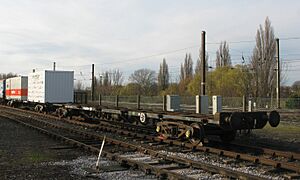
Early Days with British Rail
The idea of moving goods in standard-sized containers began in the UK in the 1930s. But it was Dr. Richard Beeching who really pushed for container trains in the UK. He suggested building 55 special depots across the country. Trains would carry containers between these depots.
British Railways worked on this idea. They planned for wagons that were 40 feet long. These wagons would carry standard international shipping containers. These containers were 8 feet by 8 feet. They came in lengths from 10 to 27 feet. Later, they were adapted to 20 to 40 feet. These standards became the basis for the international ISO 668 standard. Large cranes would move containers between trucks and trains at these depots.
In 1964, the first test wagon was made. Later that year, 100 more wagons were built. The first train carrying goods ran on November 15, 1965. It went from North London to Glasgow. Soon, this service was called Freightliner. On August 20, 1968, the first train for a single customer ran. It carried special 30-foot containers. These containers held parts for Ford Escort cars. The parts were going to factories in Europe.
Freightliner Becomes a Separate Company (1968)
Dr. Beeching first thought Freightliner would serve the UK's internal freight market. By 1968, British Railways had built 17 special depots for this. However, Freightliner made the most money from routes that served Britain's main ports. This included traffic to and from Europe and Ireland. It also included goods coming from or going to other parts of the world.
This focus on ports was recognized in the Transport Act 1968. Freightliner became a separate company. It was fully owned by the UK Government. But it rented its train services from British Railways.
By the end of the 1960s, Freightliner ran 28 terminals and 56 routes. But the company kept focusing more on international port traffic. Many of the original depots that didn't serve ports either never opened or closed. Meanwhile, they invested more in seaport depots. These included Southampton, Harwich, and the Port of Felixstowe. Freightliner also used its own network of trucks more. This helped each rail depot serve a wider area. It also made train routes longer and more efficient.
Dudley Freightliner Terminal opened in October 1967. It was about 10 miles from Birmingham. This terminal was very profitable at first. But the Birmingham terminal was not doing well financially. In 1981, Freightliner planned to close Dudley. They wanted to move its work to Birmingham. Dudley got a short break in 1983 but finally closed in 1986.
More traffic to Ireland led to a depot opening at the Port of Holyhead. Freightliner also had operations in Belfast and Dublin. The UK Government gave Freightliner money to build a new terminal at the Port of Liverpool. This was to bring back lost rail freight traffic. They also invested in more terminals at Felixstowe and the Port of Tilbury.
Back with British Railways
The Transport Act 1978 brought Freightliner back under British Railways' control. This was mainly because money was needed to make railway lines bigger. This would allow them to carry taller shipping containers.
Freightliner asked British Rail to allow 8-foot 6-inch containers on the East Coast Main Line (ECML). This meant lowering the track in some areas. Work was done successfully in some places. But Penmanshiel Tunnel collapsed in March 1979 during the work. Two workers died, and the ECML was cut off. The tunnel was too damaged to fix. So, a new section of track was built around it. Freightliner later stopped its services on that part of the ECML.
In the 1980s, Freightliner became part of British Rail's Railfreight Distribution (RfD) division. This was the first time Freightliner had its own locomotives. In 1990, British Rail ordered 700 flat wagons. These could carry 8-foot 6-inch containers at 75 mph. More wagons were leased in 1991. They also tested wagons that could carry 9-foot containers at up to 90 mph. This led to an order for 45 "Lowliner" wagons. These wagons had a very low deck. This allowed them to carry 9-foot containers on lines meant for 8-foot 6-inch containers.
These Lowliner wagons were meant for the whole British Rail network. But they were delivered slowly. So, they were all used to carry 8-foot 6-inch containers to and from London Thamesport. This helped avoid tight spots on older railway lines. Freightliner's service to Northern Ireland also ended. This happened when Sealink stopped its dedicated freight service from Holyhead.
Becoming a Private Company (1995)
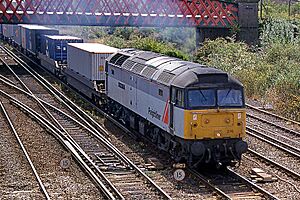
As part of the Privatisation of British Rail, the RfD division was losing money. This led to the closure of some parts of the business. Freightliner closed its remaining depots that served only domestic traffic. These included depots in London, Bristol, and Glasgow. Manchester's traffic was moved to a new Euroterminal.
Freightliner's assets were moved into a new company, Freightliner (1995) Limited. This was done to prepare for its sale. Another company, English Welsh & Scottish Railway, decided not to buy it. They thought it wasn't profitable enough. On May 25, 1996, Freightliner was bought by its managers. This was supported by 3i and Electra Private Equity for £5.4 million. As part of the deal, the UK Government gave the company a grant of £75 million until the year 2000.
Freightliner needed more reliable trains right away. In 1997, the company asked Brush Traction to rebuild six of its Class 47 locomotives. These became the Class 57 trains. They had reconditioned engines and improved parts. The first one was ready in July 1998. It also showed off Freightliner's new green paint scheme. Freightliner was happy with them and ordered six more in June 1999. They planned to have 25 of these trains. However, no more Class 57s were delivered. This was because the company decided to order new Class 66s instead. These were leased from Porterbrook.
In 1999, Freightliner started its Heavy Haul business. In March 2004, Freightliner launched Logico. This service offered short-term spaces on container trains. It was often used at big British freight hubs. By 2014, Freightliner was trying to run more such trains. This was to meet requests for more frequent services from ports.
In 2007, Freightliner began working in Poland. Their main work there was moving aggregates and coal.
Recent History
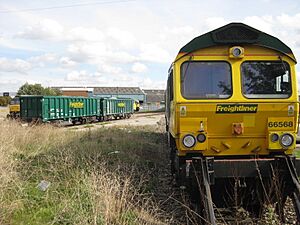
On June 13, 2008, Arcapita Bank of Bahrain bought Freightliner Group.
On June 30, 2009, Freightliner started working in Australia. They got a contract to move cotton in New South Wales. Over the next six years, they became a rail service provider in other Australian states. They also started moving coal and other farm goods for various customers.
In February 2015, Genesee & Wyoming bought Freightliner from Arcapita Bank. Genesee & Wyoming bought 95% of the company. This increased to 100% in 2020. When it was bought, Freightliner had about 250 locomotives and 5,500 wagons. It also had over 2,500 employees worldwide.
On November 12, 2015, a British Rail Class 47 train (No. 47830) was named Beeching's Legacy. This marked 50 years since the first container train ran under British Rail.
In April 2018, Freightliner showed off its new company look. This made the brand match its parent company, Genesee & Wyoming.
On July 1, 2019, it was announced that Brookfield Infrastructure and GIC would buy Genesee & Wyoming. This deal was worth US$8.4 billion.
In April 2024, Freightliner UK and Europe separated from Genesee & Wyoming. They became sister companies. This is because both are still owned by Brookfield and GIC.
What Freightliner Does
United Kingdom Operations
When Freightliner became private in 1996, it only moved containers. These trains ran from ports like Felixstowe and Southampton. They went to terminals in cities like Birmingham, Manchester, and Leeds. The network has grown, with more places added. Freightliner also has a large road network with 300 trucks. Freightliner also provides drivers for some passenger train services.
In 1999, Freightliner started Heavy Haul. This business first moved railway materials for Network Rail. They moved things like ballast and rails. Later, they started moving other bulk goods. These included aggregates, cement, coal, and scrap metal. Heavy Haul was hit hard during the Great Recession that started in 2008. But by 2015, the company was buying more wagons and hiring more staff. This was to handle new growth and the return of demand from customers. Also, because there weren't many empty spots on main railway lines, they focused on running longer trains.
In April 2006, Freightliner Maintenance Limited was created. This company focuses on fixing and maintaining trains and wagons. It took over a maintenance depot in Leeds and hired 13 staff that year. It became responsible for maintaining Freightliner's 75 Heavy Haul locomotives. Within three years, it also started maintaining wagons. It was able to keep 95% of the company's coal wagons ready to use. It also had teams in other cities for scheduled maintenance and emergency calls. This subsidiary competes for maintenance work. By 2011, Freightliner Maintenance was servicing all 111 of the company's UK-based Class 66 locomotives. It also started working on track maintenance and rail freight development.
In October 2021, the company switched most of its electric trains to diesel trains. This was because electricity costs had increased. One month later, Freightliner announced good results from a test of alternative fuel for its diesel trains. This fuel reportedly cut carbon emissions in half.
Poland Operations
In 2006, Freightliner started working in Poland. A new company, Freightliner PL Sp. z o.o., was set up. It was created to bid for contracts to move coal. The first contract was for coal transport from a mine near Bogdanka to Kozienice Power Station. This service began in September 2007. Most of Freightliner PL's services run between Gdańsk and Warsaw and in southern Poland. In February 2015, Freightliner PL signed a €17.5 million contract. This was to lease five Newag Gliwice electric locomotives called E6DCF Dragon. These trains have a diesel engine for short distances. They were delivered from May to July 2016. Freightliner also sent 13 of its Class 66 locomotives from the UK to Poland for use there.
Australia Operations
Freightliner began looking for opportunities in Australia in April 2007. By June 2008, Freightliner Australia was approved as a rail operator in New South Wales. By September 2009, it was also approved in Queensland and Western Australia. In June 2009, Freightliner Australia started moving cotton containers. These went from Wee Waa to Port Botany. In September 2009, Freightliner Australia signed a 10-year deal with Xstrata. This was to haul coal from the Hunter Valley to Newcastle. This service started in September 2010. Xstrata owned the trains and wagons. Freightliner Australia provided the engineering, logistics, maintenance, and operations. In May 2012, Freightliner Australia started a service from Warren to Port Botany.
In December 2016, Glencore bought Xstrata. Glencore then sold its Hunter Valley coal hauling business to Genesee & Wyoming Australia. This company was also owned by Freightliner's parent company, Genesee & Wyoming. Freightliner's Australian business was combined with Genesee & Wyoming Australia. The Freightliner brand was then retired in Australia.
Netherlands Operations
In 2013, Freightliner bought European Rail Shuttle B.V.. This was a company in the Netherlands that moved containers. It was bought from Maersk Line. This company focused on moving containers across borders in Europe. These trains ran between northern European ports like Rotterdam and Hamburg. They went to cities across Germany, Poland, Italy, and other parts of Europe. In 2018, the business was sold to Hupac, a company based in Switzerland.
Freightliner's Trains
United Kingdom Fleet
Freightliner received older Class 47 diesel locomotives and Class 86 and Class 90 electric locomotives from British Rail.
In 1997, Freightliner ordered six Class 57 locomotives. These were rebuilt from Class 47s. They were given new engines and improved parts. This made them more reliable and perform better. The first one was delivered in July 1998. Freightliner was happy with them and ordered six more in June 1999.
In the late 1990s and early 2000s, Freightliner ordered many new Class 66s. They ended up with 111 of these locomotives. To pull heavier trains, Freightliner changed some of its Class 66s. This made them slower but stronger. Once in use, these trains were very reliable. Freightliner reported that they were available 98% of the time. They also traveled an average of 70,000 miles between breakdowns. This was more than double that of the Class 57 trains. By 2004, the company's Class 66s had replaced all the Class 47s. They also replaced the Class 57s two years later. Freightliner also leased some Class 66s that used to be operated by Direct Rail Services.
In November 2007, Freightliner ordered 30 Class 70s. This project was called Project Genesis. The first two were delivered in November 2009. These new trains allowed Freightliner to send some Class 66s to other companies. Five went to Colas Rail, 13 to Freightliner Poland, and four to GB Railfreight.
Freightliner also used its single Class 47 (47830) for driver training. In 2024, 47830 was sold to Locomotive Services Limited. It was repainted in British Rail Green.
Poland Fleet
Freightliner PL ordered seven EMD Series 66 locomotives. They also ordered 432 coal hopper wagons. These were joined by a Class 66 that used to be with Häfen und Güterverkehr Köln. Also, 12 Class 66s were moved from Freightliner's UK operations. A 13th was sent from the UK in October 2012. These trains were changed to work on the Polish railway network.
Australia Fleet
Freightliner Australia started operations using rented GL class locomotives. These were from Chicago Freight Car Leasing Australia (CFCLA). After a longer rental agreement, two were repainted in Freightliner colors in September 2010. The Warren service that started in May 2012 also used locomotives rented from CFCLA. Two CF class locomotives were repainted in Freightliner colors. The Xstrata coal contract used XRN class locomotives. These were owned by the customer.
In January 2015, two G class locomotives were bought.
Netherlands Fleet
Freightliner's Netherlands operations used various types of locomotives. These included Vossloh G1206 and Vossloh G 2000 diesel trains for shunting and local work. They also used EMD Class 66 diesel trains, but these were later withdrawn. For electric operations, they used BR182, BR185, and BR189 electric locomotives.
See also
- Intermodal railfreight in Great Britain
Images for kids
-
57012 Freightliner Envoy at Ipswich in 2004
-
66 610 on the East Coast Main Line near York in 2008
-
86613 and 86610 at Ipswich in 2004



